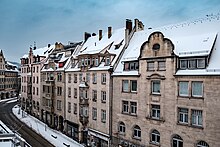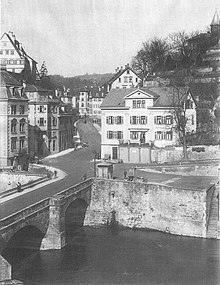Mühlstrasse (Tübingen)


The Mühlstrasse in Tübingen is a central street through the cut in the terrain between the old town and Österberg .
It connects via the Neckar leading Eberhardsbrücke with the Lustnauer Tor . Neckargasse , Gartenstrasse and Eberhardsbrücke meet at the south end, and Wilhelmstrasse begins at the north end ; the Neue Straße , the Doblerstraße , the Österbergstraße and the Pflegehofstraße meet here to form a small square at the Lustnauer Tor (also known as the “Schimpf-Eck”).

Surname
Mühlstrasse takes its name from the three former mills ( grain , fulling and powder mill ) that were operated with the water from the Ammer Canal . Around 1450 the city decided to have the Österberg between Ammertal and Neckar valley pierced. The Ammer Canal was diverted directly into the Neckar through the new ditch. With a gradient of around 8.5 meters between the Ammer and Neckar valleys, it was possible to operate the three mills.
The ducal powder mill was located at the lower end of the mill ditch until 1706. Like the grave mill located further up, it was probably built soon after the trench was completed. After a series of accidents - the last one the entire mill exploded - Duke Eberhard Ludwig ordered its relocation in 1706 and had the new building erected far outside the city in front of the Haagtor . The city acquired the old place of the powder mill in order to build another flour mill, the so-called Neumühle, on it in 1708. Together with the other municipal mills, it was also privatized in 1835 and subsequently rebuilt several times.
During the Nazi era , the street was called Adolf-Hitler-Strasse until 1945 .
construction
The road was built from 1885 to 1887 instead of the former Mühlweg. The already existing but narrow cut in the terrain was widened somewhat, and the flour mill, fulling mill and powder mill were removed. Clemens & Decker was used as the construction company . The wall facade of the slope supports was modeled on the Hohenzollern Castle . On the west side, it largely replaced the old city wall there and is therefore, in a slightly romantic way, modeled on a fortification wall with battlements. A piece of the original city wall with four loopholes is still preserved at the lower end.
The aim of expanding Mühlstrasse was to make it the “liveliest and most beautiful” street.
building
The architectural style of the buildings in the upper Mühlstrasse, built around the turn of the century, comes from historicism and the so-called " Nuremberg Style " that appeared around 1880 . This is characterized by the adoption of locally distinctive decorative forms from the historical inventory. It mainly refers to the transition from late Gothic to early Renaissance - the time in which Tübingen experienced a great boom, even if at that time almost only in half-timbered construction. The driving force behind the development of this style was Konradin Walther, professor at the Nuremberg School of Applied Arts, with his students. Despite the imitation of the Middle Ages, Mühlstrasse was the first address for modern luxury. Wine and tobacco shops, photographers, gentlemen's outfitters (Knecht in No. 12) and jewelers were there - and independent women: the dance teacher Lina Anweiler-Kloren (No. 10) and the typist Berta Wochele in No. 18. In 1942 Berta ran here Leibbrand a vegetarian pension. The seven houses of this architectural style were built between 1900 and 2003, including the "German House" with a bay window and stepped gable at the corner of Lustnauer Tor. In 1900 the "König Karl" restaurant was located in the somewhat older house No. 8.
Transport and planning
For a long time, the road was the only connection between the north and south of the city that could be used by motor vehicles and it was often congested with traffic. Only the four-lane tunnel of the B 28 , which is located far to the west, provided a certain degree of relaxation. From the Neckar in the direction of Wilhelmstraße and Ammertal, cars are allowed to use the Mühlstraße today, from the Lustnauer Tor downwards only taxis, buses, bicycles and emergencies have been allowed since 1993.
As part of the project inside: City of the city administration , measures for the extensive renovation, beautification and upgrading of Mühlstrasse were carried out in 2009. Details were heatedly discussed beforehand, during and afterwards.
From June 28th to the end of November 2009, this construction work, including the demolition of the Mühlstrasse 3 building and the paving work on the Neckar Bridge, were closed to traffic. The buses were also no longer allowed to drive through this street during this time.
The roadway on Mühlstrasse was restricted to a minimum width. Meter-thick concrete slabs are supposed to give it stability for a long time, the surface was given a transparent coating. The previously asphalted pavement has been widened and paved with light-colored concrete blocks, but is now also cleared for cyclists to ride uphill, while there is no separate cycle path. Short-term parking spaces have also been created on the sidewalk area. Several small trees with wooden trellises green this area. The retaining wall from 1887 was stabilized by several metal anchors drilled into it. The street is illuminated by new lighting (lanterns and floor spotlights on the wall).
Mayor Boris Palmer is in favor of blocking Mühlstrasse for through traffic, including from the south, but does not want to enforce this against a possibly different majority in the population. He suggests a referendum on this. A citizens' initiative from Österberg was formed in 2012 against a full closure.
Stairs, path and bridge
Between 2011 and 2013, after controversial debates, a new staircase at the site of the demolished house at Mühlstrasse 3 became an equally new footpath above the city wall on the green Schulberg slope on Pflegehofstrasse and at the Schwarzes Schaf bar (formerly Tangente-Night) on upper Mühlstrasse built. Discussions about traffic improvements, a footpath on Schulberg and a bridge between the old town and Österberg began as early as the late 1940s.
Individual evidence
- ↑ From Mühlgraben to Mühlstraße www.tue-markt.de ( Memento of the original from December 19, 2014 in the Internet Archive ) Info: The archive link has been inserted automatically and has not yet been checked. Please check the original and archive link according to the instructions and then remove this notice.
- ^ Little Tübingen town history ( Silberburg-Verlag , 2006, p. 154, ISBN 978-3-8425-1287-0 )
- ↑ “The Mühlstrasse in Tübingen. Decoration of the city? "Brochure City Archives Tübingen (1990)
- ↑ Tübingen city chronicle from 1900
- ↑ 1903 city map
- ^ Tübingen city chronicle from 1993
- ↑ www.tagblatt.de of June 26, 2009 ( Memento of the original of December 19, 2014 in the Internet Archive ) Info: The archive link was automatically inserted and not yet checked. Please check the original and archive link according to the instructions and then remove this notice.
- ↑ Schwäbisches Tagblatt January 2010
- ^ Palmer wants referendum , Tagblatt January 28, 2011
- ↑ Citizens' initiative wants to prevent Mühlstrasse blocking , daily newspaper April 1, 2012
- ↑ Zeit-zeugnisse.de with pictures and old plans (Sept. 2011).

